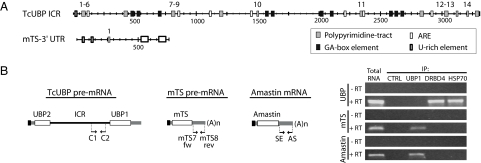Fig. 5.
Functional cis-acting elements in the noncoding regions of TcUBP dicistron interact in vivo with DRBD4 and HSP70. (A) Scheme of cis-acting elements predicted in the ICR and mTS-3′ UTR using bioinformatics tools. Polypyrimidine tracts, GA-rich elements, AU-rich elements, U-rich elements, and PTB sites are indicated. The numbers indicate putative PTB sites. The following numbers indicate the beginning and end positions of PTB sites within the ICR: UCUUC, 103–107, 106–110, 109–113, 817–821, 977–981, 1490–1494, 2356–2360, 3052–3056, 3055–3059, and 3169–3173; and CUCUCU, 4–9, 78–83, 80–85, 82–87, 795–800, and 797–802. Within the mTS-3′ UTR, the only putative PTB-binding site found was UCUUC, 288–292. (B) Agarose gel showing the RT-PCR products of TcUBP, mTS-3′ UTR, and Amastin from total RNA, coimmunoprecipitated in vivo with control rabbit serum (immunoprecipitation control, CTRL), anti-UBP1, anti-DRBD4, or -HSP70 antibodies. RT was performed with (+) or without (−) SuperScript II enzyme. For mTS-3′ UTR cDNA synthesis, we used oligod(T)18. For TcUBP, the internal specific primer NH2/AS-ubp1 (see SI Table 3) was used. Schemes of mRNAs with 3′ UTRs and position of primers used in PCRs are shown at the left. RT, reverse transcriptase enzyme.

